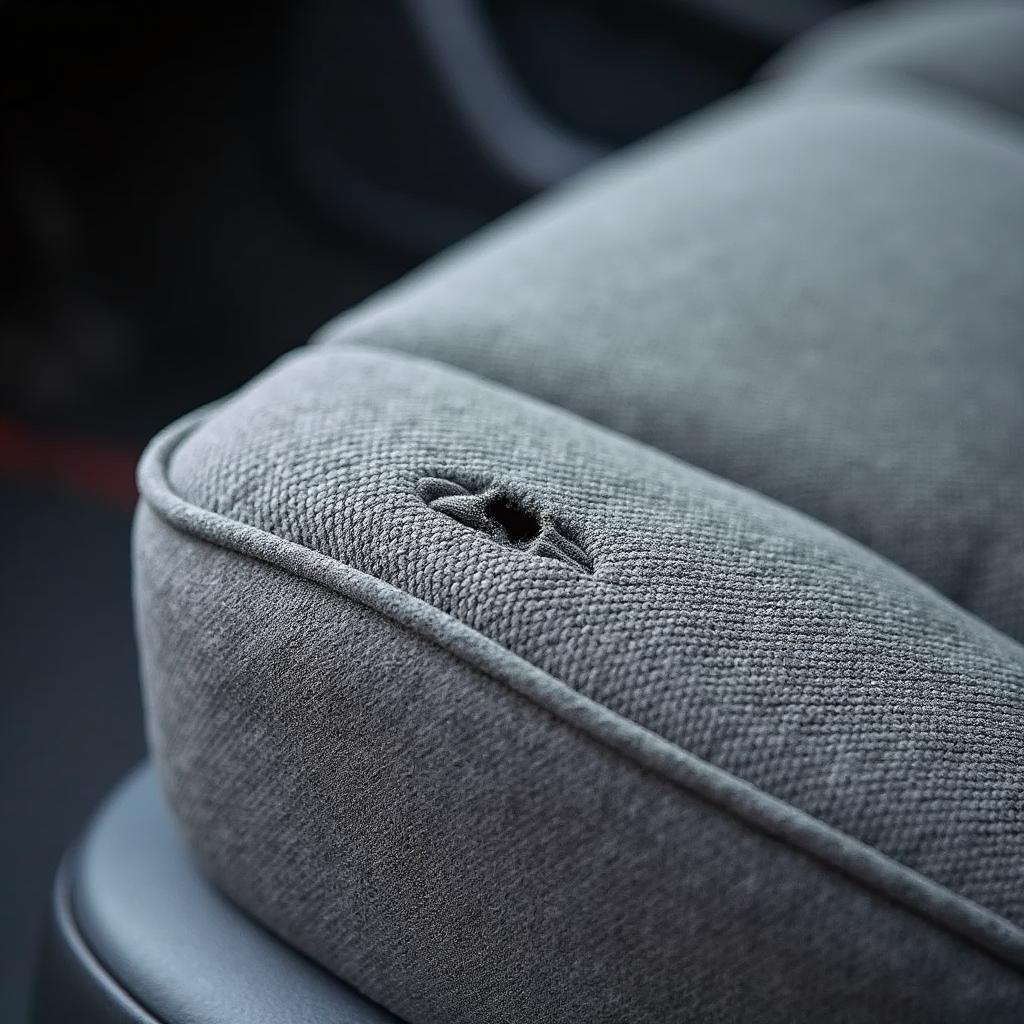A torn cloth car seat can be an eyesore and affect the resale value of your car. Luckily, you don’t always need a professional to fix it. This guide will show you how to repair a torn cloth car seat yourself, saving you money and restoring your car’s interior.
Assessing the Damage: When to DIY and When to Call a Pro
Before you grab your tools, it’s essential to evaluate the severity of the tear. Small rips and burns can often be tackled at home, while larger tears or those affecting the seat’s structural integrity might need a professional touch.
Here’s a simple breakdown:
- DIY-able: Small tears, burns, cigarette holes, seam separation.
- Professional Help: Large tears, tears on the side bolster, tears involving airbags, extensive damage.
Gathering Your Tools and Materials
Having the right tools is crucial for a successful car seat repair. Here’s what you’ll need:
- Cleaning Supplies: Vacuum cleaner, upholstery cleaner, microfiber cloth.
- Repair Materials: Depending on the repair method you choose, you might need a patching kit, fabric glue, a needle and thread, or a liquid leather vinyl repair kit.
- Tools: Scissors, tweezers, a palette knife or spreader.
How to Repair a Fabric Car Seat: Step-by-Step Methods
Let’s dive into the repair process. Remember to choose the method that best suits the type and size of the tear.
Method 1: Using a Patching Kit for Small Tears
Patching kits are ideal for small tears and burns. They usually contain adhesive patches and color-matching fabric to blend the repair seamlessly.
- Clean the area: Thoroughly vacuum and clean the torn area with upholstery cleaner to remove dirt and debris. Allow it to dry completely.
- Prepare the patch: Choose a patch slightly larger than the tear and trim it to match the shape of the damaged area.
- Apply the patch: Peel off the backing from the adhesive patch and carefully align it over the tear. Press firmly to secure it in place.
- Blend the repair: If your kit includes color-matching fabric, cut a small piece and apply it over the patch using fabric glue for a seamless finish.
Method 2: Repairing Tears With Fabric Glue
Fabric glue is a versatile option for repairing small to medium-sized tears and frayed edges.
- Clean the area: Clean and dry the area around the tear as described in Method 1.
- Apply fabric glue: Apply a thin layer of fabric glue along the edges of the tear, being careful not to overuse it.
- Press and hold: Press the edges of the tear together firmly and hold for a few minutes to allow the glue to bond.
- Use clamps (optional): For larger tears, consider using clamps to hold the edges together while the glue dries completely.
how to repair a fabric car seat
Method 3: Stitching for Larger Tears and Seam Repair
Stitching is a more durable option for larger tears or if you need to repair a car seat seam.
- Choose the right thread: Select a heavy-duty thread that matches the color of your car seat’s upholstery.
- Thread the needle and knot the end: Thread a curved upholstery needle and tie a secure knot at the end.
- Stitch the tear: Starting from the backside of the fabric (if possible), carefully stitch the edges of the tear together using a straight stitch or a whipstitch.
- Knot and secure: Once you’ve finished stitching, tie a secure knot at the back of the fabric to prevent unraveling.
Expert Tip from John Miller, Automotive Upholstery Specialist: “When stitching, try to keep your stitches small and even for a professional-looking repair. Avoid pulling the thread too tight, as this can pucker the fabric.”
Preventing Future Tears: Tips for Protecting Your Car Seats
Prevention is always better than cure. Here are some tips to protect your car seats from future damage:
- Use Seat Covers: Seat covers are a great way to protect your seats from spills, dirt, and wear and tear.
- Be Mindful of Sharp Objects: Avoid placing sharp objects like keys, tools, or toys on your seats.
- Clean Spills Immediately: Spills can stain and damage fabric seats if not cleaned up quickly.
- Regular Cleaning: Vacuum and clean your car seats regularly to prevent dirt and grime from building up.
How to Repair a Torn Cloth Car Seat: FAQs
Here are some frequently asked questions about repairing torn cloth car seats:
Q: Can I use duct tape to repair a torn car seat?
A: While duct tape might seem like a quick fix, it’s not recommended for car seat repairs. Duct tape adhesive can leave a sticky residue and won’t provide a lasting solution.
Q: How long does fabric glue take to dry?
A: Most fabric glues dry to the touch within a few minutes but require 24-48 hours to cure completely.
Q: Where can I find matching fabric for my car seat?
A: You can often find matching or similar fabric at fabric stores, online retailers, or even at junkyards if you need a specific pattern or color.
Conclusion
Repairing a torn cloth car seat is a manageable DIY project that can save you money and restore your car’s interior. Remember to assess the damage carefully and choose the repair method that best suits your needs. By following these steps and taking preventative measures, you can keep your car seats looking their best for years to come.



